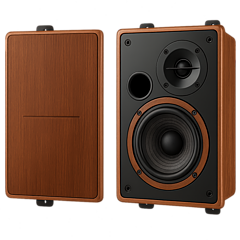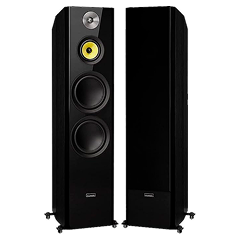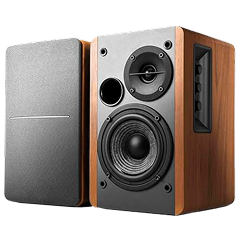There’s something that’s visually impressive about a pair of floorstanding speakers, isn’t there? Provided they’ve been carefully constructed and finished, it’s possible to make a case for them as ‘furniture’ almost as much as for ‘loudspeakers’.
This guide will walk you through what floorstanding speakers are, the specs that matter, and how to match them to your space and setup, so you can get the sound you want without over- or under-spending.
What Are Passive Floorstanding Speakers?
Passive floorstanding speakers are tall, freestanding units designed to sit directly on the floor (as opposed to bookshelf speakers, which sit on stands or shelves). Being “passive” means they require an external amplifier or AV receiver to power them.
Compared to smaller bookshelf models, floorstanders generally:
- Have larger cabinets that can house bigger or more drivers.
- Deliver deeper bass and a fuller soundstage.
- Fill larger rooms more easily without distortion at high volumes.
The most obvious difference, of course, is physical. A floorstanding speaker is, naturally, designed to stand on the floor rather than be placed on a shelf or have its cabinet supported by a stand.
A bigger cabinet like this allows for bigger, and sometimes more numerous, drivers — and if you’ve read our main guide for buying speakers you’ll know that ‘bigger drivers = greater air-movement’, which in turns means ‘greater scale’ and ‘deeper bass’. So if it’s a big sound with real bass extension you require, and you have a room large enough to allow these bigger speakers to operate freely, a floorstanding design could well be for you.
The Price Factor
While you don’t need to budget for stands, the price gap between bookshelf speakers and their floorstanding counterparts can feel disproportionate. But there are solid reasons for this.
Building a cabinet that stands a meter tall or more requires more materials. The larger internal volume must be carefully designed to prevent disruptive sound waves inside the cabinet. Unchecked, these waves can hinder driver performance and cause the cabinet itself to resonate. To avoid this, manufacturers use bracing and internal damping, which add to cost.
Plus, there’s the additional expense of larger and more numerous drivers.
Entry-level floorstanding speakers start around $500–700 per pair, with mid-range options running $1,000–3,000. High-end models with advanced cabinet bracing and premium drivers can easily exceed $5,000.
Matching Speaker Size to Room Size
Larger loudspeakers, capable of moving plenty of air and creating a full-scale soundstage, require a relatively large space in which to operate. Otherwise, sound waves will reflect too quickly from walls and create imbalance. You want precision, stereo focus, and a convincing soundstage – none of which is possible if the speaker is too big for the room.
And don’t forget: every speaker does its best work when given free space. Avoid putting floorstanders in a corner or too close to walls, and account for any bass reflex ports when planning placement.
- Rooms under 200 sq. ft. → Consider smaller floorstanders with slimmer cabinets.
- Rooms 250–400 sq. ft. → Standard floorstanders with 6–7 inch woofers will typically perform well.
- Rooms over 400 sq. ft. → Larger multi-driver designs (including dedicated sub-bass drivers) are ideal.
Leave at least 1–2 feet of clearance from back and side walls for best imaging.
Expectations of Frequency Response
When it comes to sensitivity, impedance, and distortion, floorstanding speakers share the same rules as bookshelf models. Where they stand out is frequency response.
Every loudspeaker should hit the 20kHz mark at the top of the frequency range, since this is the limit of human hearing. But only large drivers can generate the low-frequency sound waves needed to reach below 50Hz.
Delivering bass down to 20Hz is beyond all but the largest and most expensive floorstanders. Still, a capable design should extend to at least 40Hz to produce deep, satisfying bass.
- Treble: Expect all models to reach 20kHz.
- Bass: Look for models that reach at least 40Hz (-3dB). Premium designs may extend to 25–30Hz.
- Sensitivity: 88–90 dB is common; anything above 90 dB will be easier to drive.
- Impedance: 8 ohms is standard; 4 ohm models may demand a powerful amplifier.
Amplifier Matching
Because floorstanders often have multiple drivers and lower impedance ratings, they can place more demands on an amplifier than bookshelf speakers. Matching your amp’s power output to the speaker’s requirements is critical for avoiding distortion and getting the most out of the drivers.
Choose an amplifier that delivers at least 75–150 watts per channel into 8 ohms for most mid-sized floorstanders. If your speakers dip to 4 ohms, make sure your amp is stable at 4 ohms and can deliver clean power without strain.
Bi-Wiring and Bi-Amping Options
Many floorstanding speakers have dual binding posts, which allow bi-wiring (separating bass and treble signal paths) or bi-amping (using two amplifiers for separate frequency ranges). While not essential, these features can offer more flexibility and, in some cases, improved performance.
Even if you don’t plan to bi-wire or bi-amp now, having the option makes your purchase more “future-proof.”
Cabinet Build and Materials
The size of floorstanding speakers makes cabinet construction quality especially important. Poorly built enclosures can resonate, causing unwanted coloration. Look for solid cabinet bracing, thick MDF or composite wood, and damping material inside.
High-quality models often use MDF at least 18–25mm thick, with internal bracing to reduce panel vibration. Some premium speakers use layered or composite materials for extra rigidity.
Aesthetics and Finish
Since floorstanders are larger and more visible in a room, their design and finish matter more than with small bookshelf speakers. Consider veneer, lacquer, or painted finishes that complement your space, especially if your speakers will be prominent.
Dark wood and matte black finishes are classic, while gloss finishes or exotic veneers tend to appear on higher-end models.
Integration With Subwoofers
Although floorstanders reach deeper into the bass than bookshelves, some users still choose to add a subwoofer for home theater use or for very large rooms. Integration is smoother with speakers that have tight, controlled bass.
If your floorstanders already reach 35–40Hz cleanly, a subwoofer may not be necessary for music. For home theater, pairing floorstanders with a subwoofer that extends to 20Hz is ideal.
What Else to Listen For
Good low-frequency extension is important in a floorstanding speaker, but control of those low frequencies is just as crucial. Without proper control, bass can become loose and imprecise, making rhythms sound sluggish.
The difference between a speaker that can accurately express the “start” and “stop” of bass notes and one that cannot is huge. Controlled bass makes music feel natural and engaging, and it keeps complex recordings from sounding muddy.
Beyond bass, listen for:
- Detail retrieval – Are subtle background instruments clear?
- Dynamic range – Can the speaker shift convincingly from soft passages to loud crescendos?
- Soundstage width and depth – Does the music feel like it fills the room rather than sitting flat between the speakers?




















